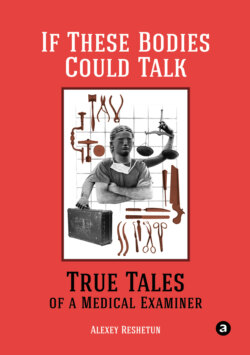If These Bodies Could Talk: True Tales of a Medical Examiner

Реклама. ООО «ЛитРес», ИНН: 7719571260.
Оглавление
Алексей Решетун. If These Bodies Could Talk: True Tales of a Medical Examiner
FOREWORD TO THE NEW EDITION
INTRODUCTION
PART ONE. LAYING THE GROUNDWORK
1. WHAT EXACTLY IS FORENSIC MEDICINE?
2. JUST WHO IS A MEDICAL EXAMINER?
3. PATHOLOGIST OR MEDICAL EXAMINER? WHAT IS SIMILAR, WHAT IS NOT
4. TO CUT OR NOT TO CUT? THAT IS THE QUESTION
PART TWO. THE PROFESSIONAL
1. OUR TOOLS
2. PUT ON YOUR LAB COAT
3. WHEN THE CURE IS WORSE THAN THE DISEASE
4. LAND OF THE LIVING
5. STUDENT LIFE
PART THREE. WORKING WITH THE DEAD
1. PHENOMENA OF PHENOMENA
2. EXAMINING A BODY: EXPECTATIONS AND REALITIES
3. EXHUMATION
PART FOUR. TRAUMA
1. A BAT, A HAMMER, A STICK, AND OTHER WAYS TO DIE: BLUNT HARD OBJECTS
2. FORKS OVER KNIVES: ONE HOLE VERSUS FIVE – SHARP INSTRUMENTS AND THE WOUNDS THEY LEAVE BEHIND
3. BUCKLE UP FOR SAFETY, BUCKLE UP!
4. GUNSHOTS AND EXPLOSIONS IN TIMES OF PEACE
5. MASS CASUALTY INCIDENTS
6. OFF WITH HER HEAD!
PART FIVE. ASPHYXIATION
1. HANGING: FACT AND FICTION
2. STRANGULATION: "EVENTUALLY, IT ALL COMES TO LIGHT"
3. DEATH IN THE WATER: SOMETIMES IT IS DROWNING, SOMETIMES IT IS NOT
4. THERE'S NO LIFE WITHOUT AIR
5. WARNING! CHOKING HAZARD
PART SIX. HEAT AND ELECTRICITY
1. FAIR HEAT BREAKS NO BONES
2. THE COLD NEVER BOTHERED ME, ANYWAY
3. I AM IN SHOCK
PART SEVEN. DRUGS AND ALCOHOL
1. DRINK LIKE A FISH
2. SAY NO TO DRUGS!
PART EIGHT. CHILDREN
1. CANNIBAL PARENTS
2. YOU ARE GOING TO POKE AN EYE OUT!
3. PARENTAL NEGLECT
PART NINE. DISEASE
1. SUDDEN DEATH: CARDIOVASCULAR DISEASES
2. CANCERS
3. TUBERCULOSIS AND HIV
PART TEN. MYTHS
1. OLD WIVES' TALES
2. WORMS AND FECAL STONES
3. SMELLS
PART ELEVEN. MISCELLANEOUS
1. MORGUE-TURNED-ABORTION CLINIC
2. A BAD NEIGHBORHOOD
3. TRANSGENDER AND INTERSEX CASES
4. TRAIN AND QUARRY
5. A FUNNY STORY
6. SPIRITUALITY
CONCLUSION
BIBLIOGRAPHY
Отрывок из книги
It has been over a year since the first edition of my book was published. During that time, I have given many talks in several cities, given media interviews, and even been recognized in the street a few times (I am famous!). I have received over one hundred letters, both emails and handwritten, two of which invited me to join an organization to save the universe, the others simply expressing gratitude. I answered all of them, other than the two from another realm. It is nice when all kinds of people you do not even know like your work. That was a new feeling for me, something I was not used to. Before the first edition came out, I had no idea what kinds of things readers would share with me. I learned that many of them were really interested in finding out more about my specialty, that they were able to look beyond old prejudices, and some were even able to re-evaluate their lives. It would seem that my work was done. After all, the book came out, and people liked it. But, my dear readers, you have rightly pointed out to me that some things were missing from the book. I have tried to include them all here.
In this new edition, I will talk about the many types of tools we use at work. Each of them has a specific purpose. I will also talk about what we do in the lab, about exhumations, motorcycle injuries, dismemberment, and iatrogenesis, and, finally, about some of my favorite students.
.....
It is necessary to distinguish what exactly constitutes a "violent death." Most people assume that if someone is not found with an axe sticking out of their head, their death was not violent. In fact, things are not that simple. Any death that occurs due to factors in someone's external environment – cold temperatures, alcohol, carbon monoxide, or, yes, an axe wound – is considered violent. Intent does not matter here – if someone died from alcohol poisoning, whether he drank too much of his own free will, if someone poured vodka down his throat, or he drank it by accident is of little importance. In any case, the death will be considered violent.
In fact, only three types of death are considered non-violent: (1) death from disease (for example, our heart attack patient above, or someone who dies of pneumonia, a stroke, etc.); (2) death from old age (medical examiners will only see one of these cases every couple of years); and (3) death as the result of a stillbirth caused by congenital anomalies.
.....